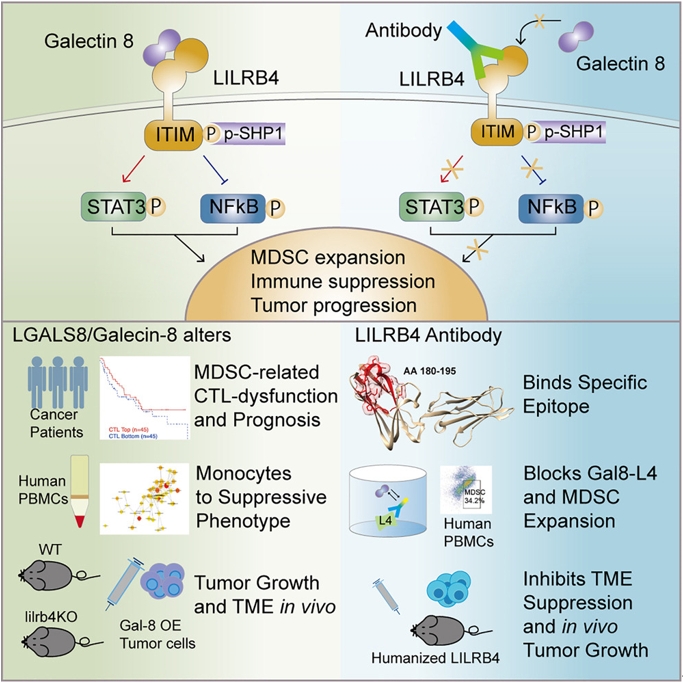Cell Reports Medicine: BioTroy Therapeutics jointly published Galectin-8’s role in tumor immune evasion
Recently, BioTroy Therapeutics and the research team led by Professor Xu Jie from Fudan University published an article titled "Discovery of Galectin-8 as an LILRB4 ligand driving M-MDSCs defines a class of antibodies to fight solid tumors" in the journal Cell Reports Medicine,This study for the first time reports Galectin-8 as a tumor-associated functional ligand for LILRB4. It induces M-MDSCs through downstream STAT3 and NF-κB pathways, thereby promoting tumor immune evasion and growth. Therapeutic antibodies that block Galectin-8 and LILRB4 have been developed, demonstrating their potential therapeutic and translational value in slowing down the growth of various tumors with high Galectin-8 expression in mice.

Myeloid-derived suppressor cells (MDSCs) play a crucial role in the tumor immune microenvironment, but the development of targeted drugs faces challenges due to the lack of specific targets. LILRB4 is an immune checkpoint receptor with an ITIM domain, associated with MDSC-mediated tumor immune suppression. Although drugs targeting LILRB4 have made progress in preclinical and clinical studies, the therapeutic effects are not ideal. Currently, the functional ligands of LILRB4 associated with MDSCs in the tumor microenvironment are unclear, hindering the development of blocking antibodies and companion diagnostics.
Researchers have discovered that Galectin-8 has a unique expression pattern, influencing tumor prognosis and immune infiltration factors. Galectin-8 is associated with MDSCs, and further research shows that Galectin-8 binds to LILRB4 with high affinity, regulating the intracellular SHP-1-STAT3/NF-κB pathway. Galectin-8 can induce an increase in M-MDSCs and inhibit T cell proliferation. Using a genetically knocked-out mouse model, researchers demonstrated that the presence of LILRB4 and overexpression of Galectin-8 functionally promote the increase of mouse M-MDSCs and tumor growth.
By developing antibodies against LILRB4 and Galectin-8, researchers demonstrated that bidirectional blocking could inhibit the effects of Galectin-8 and LILRB4 interaction. The researchers also analyzed the epitopes of the antibodies, especially the binding epitopes of the blocking antibodies with LILRB4, which were precisely located (shown in Figure B-C). Subsequently, using a humanized mouse tumor model, researchers proved that antibodies inhibit the growth of tumors expressing Galectin-8 (shown in Figure K-L).

Based on the abnormal overexpression of Galectin-8 in various solid tumors and the significant role of MDSCs in related tumor immune escape, the monoclonal antibodies developed in this study have good application prospects. The research also developed related companion diagnostic biomarkers, which have potential translational value.
Xu Jie, a researcher of Institutes of Biomedical science, Fudan University, is the corresponding author of this paper. BioTroy Therapeutics participated in the collaborative research, completing tasks such as the expression of target proteins and antibodies, analysis of antibody epitopes, and some functional and mechanistic studies. This project was funded by key projects of the National Natural Science Foundation of China, national science and technology innovation leading talents research funds, and BioTroy Therapeutics’ innovative drug R&D special project, among others. Relevant achievements have been jointly patented by the collaborators.
Original article link:https://www.cell.com/cell-reports-medicine/fulltext/S2666-3791(23)00603-1



